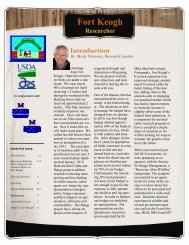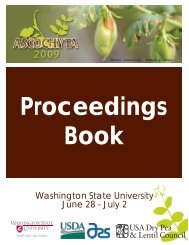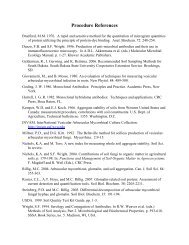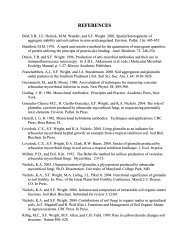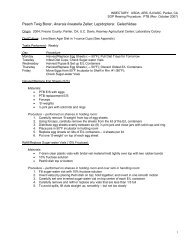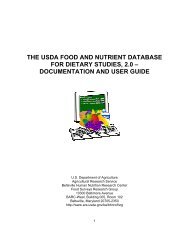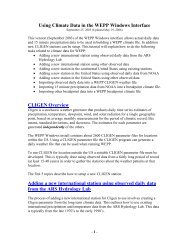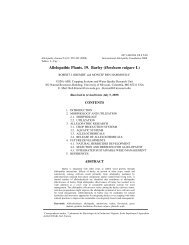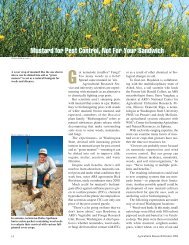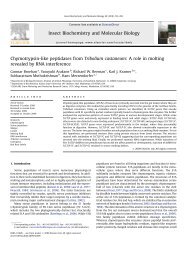Discovery and molecular mapping of a new gene conferring ...
Discovery and molecular mapping of a new gene conferring ...
Discovery and molecular mapping of a new gene conferring ...
Create successful ePaper yourself
Turn your PDF publications into a flip-book with our unique Google optimized e-Paper software.
Chromosome Res (2011) 19:669–682<br />
DOI 10.1007/s10577-011-9226-3<br />
<strong>Discovery</strong> <strong>and</strong> <strong>molecular</strong> <strong>mapping</strong> <strong>of</strong> a <strong>new</strong> <strong>gene</strong> <strong>conferring</strong><br />
resistance to stem rust, Sr53, derived from Aegilops<br />
geniculata <strong>and</strong> characterization <strong>of</strong> spontaneous translocation<br />
stocks with reduced alien chromatin<br />
Wenxuan Liu & Matthew Rouse & Bernd Friebe &<br />
Yue Jin & Bikram Gill & Michael O. Pumphrey<br />
Received: 14 March 2011 /Revised: 27 May 2011 /Accepted: 16 June 2011 /Published online: 5 July 2011<br />
# Springer Science+Business Media B.V. 2011<br />
Abstract This study reports the discovery <strong>and</strong> <strong>molecular</strong><br />
<strong>mapping</strong> <strong>of</strong> a resistance <strong>gene</strong> effective against<br />
stem rust races RKQQC <strong>and</strong> TTKSK (Ug99) derived<br />
from Aegilops geniculata (2n=4x=28, U g U g M g M g ).<br />
Two populations from the crosses TA5599 (T5DL-<br />
5M g L·5M g S)/TA3809 (ph1b mutant in Chinese Spring<br />
background) <strong>and</strong> TA5599/Lakin were developed <strong>and</strong><br />
used for <strong>gene</strong>tic <strong>mapping</strong> to identify markers linked to<br />
the resistance <strong>gene</strong>. Further <strong>molecular</strong> <strong>and</strong> cyto<strong>gene</strong>tic<br />
characterization resulted in the identification <strong>of</strong> nine<br />
spontaneous recombinants with shortened Ae. geniculata<br />
segments. Three <strong>of</strong> the wheat–Ae. geniculata recombinants<br />
(U6154-124, U6154-128, <strong>and</strong> U6200-113) are<br />
interstitial translocations (T5DS·5DL-5M g L-5DL), with<br />
Responsible Editor: Pat Heslop-Harrison.<br />
W. Liu : B. Friebe (*) : B. Gill<br />
Wheat Genetic <strong>and</strong> Genomic Resources Center Department<br />
<strong>of</strong> Plant Pathology, Kansas State University,<br />
Manhattan, KS 66506-5502, USA<br />
e-mail: friebe@ksu.edu<br />
M. O. Pumphrey<br />
Spring Wheat Breeding <strong>and</strong> Genetics,<br />
Department <strong>of</strong> Crop <strong>and</strong> Soil Sciences,<br />
Washington State University,<br />
Pullman, WA 99164-6420, USA<br />
M. Rouse : Y. Jin<br />
USDA-ARS Cereal Disease Laboratory,<br />
University <strong>of</strong> Minnesota,<br />
St. Paul, MN 55108, USA<br />
20–30% proximal segments <strong>of</strong> 5M g L translocated to<br />
5DL; the other six are recombinants (T5DL-<br />
5M g L·5M g S) have shortened segments <strong>of</strong> 5M g L with<br />
fraction lengths (FL) <strong>of</strong> 0.32–0.45 compared with FL<br />
0.55 for the 5M g L segment in the original translocation<br />
donor, TA5599. Recombinants U6200-64, U6200-117,<br />
<strong>and</strong> U6154-124 carry the stem rust resistance <strong>gene</strong> Sr53<br />
with the same infection type as TA5599, the resistance<br />
<strong>gene</strong> donor. All recombinants were confirmed to be<br />
<strong>gene</strong>tically compensating on the basis <strong>of</strong> genomic in situ<br />
hybridization <strong>and</strong> <strong>molecular</strong> marker analysis with<br />
chromosome 5D- <strong>and</strong> 5M g -specific SSR/STS-PCR<br />
markers. These recombinants between wheat <strong>and</strong> Ae.<br />
geniculata will provide another source for wheat stem<br />
rust resistance breeding <strong>and</strong> for physical <strong>mapping</strong> <strong>of</strong> the<br />
resistance locus <strong>and</strong> crossover hot spots between wheat<br />
chromosome 5D <strong>and</strong> chromosome 5M g L <strong>of</strong> Ae.<br />
geniculata.<br />
Keywords wheat . Aegilops geniculata . stem rust .<br />
Ug99 . recombinants<br />
Abbreviations<br />
STS Sequence-tagged sites<br />
PCR Polymerase chain reaction<br />
EST Expressed sequence tag<br />
NEB New Engl<strong>and</strong> biolab restriction<br />
endonuclease buffer<br />
SSR Simple sequence repeat<br />
LOD Logarithm <strong>of</strong> odds<br />
GISH Genomic in situ hybridization
670 W. Liu et al.<br />
SPOT this is not an abbreviation but the name <strong>of</strong> a<br />
camera<br />
IT Infection type<br />
FL Fraction length<br />
Introduction<br />
Stem rust <strong>of</strong> wheat, caused by Puccinia graminis f. sp.<br />
tritici, is one <strong>of</strong> the most significant threats to global<br />
wheat production (Singh et al. 2008a). The emergence<br />
<strong>of</strong> the Ug99 group <strong>of</strong> stem rust races (TTKSK, TTKSF,<br />
TTKST, TTTSK) has reaffirmed the need to deploy<br />
diverse <strong>and</strong> effective resistance sources to safeguard<br />
wheat production (Pretorius et al. 2000; Wanyera et al.<br />
2006; Jin <strong>and</strong> Singh 2006; Jin et al. 2008a, b, 2009a;<br />
Singh et al. 2006, 2008a, b). Races in the Ug99 race<br />
complex are virulent to resistance <strong>gene</strong>s deployed in<br />
most wheat varieties currently under cultivation<br />
throughout the world, <strong>and</strong> more than half <strong>of</strong> the 46<br />
catalogued wheat stem rust-resistant <strong>gene</strong>s are ineffective<br />
(Singh et al. 2006, 2008a; McIntoshetal.2008).<br />
Breeding resistant cultivars is the most practical<br />
approach to protect wheat from stem rust. Deployment <strong>of</strong><br />
combinations <strong>of</strong> effective <strong>gene</strong>s “stacked” or “pyramided”<br />
in combination with adult plant resistance should<br />
improve the durability <strong>of</strong> resistance in commercial<br />
cultivars by reducing the probability <strong>of</strong> corresponding<br />
simultaneous mutation events in the pathogen. Gene<br />
pyramiding is facilitated by the ability to use <strong>molecular</strong><br />
markers closely or completely linked to resistance <strong>gene</strong>s.<br />
Molecular markers have been developed for numerous<br />
stem rust resistance <strong>gene</strong>s, including: Sr2 (Spielmeyer et<br />
al. 2003; Haydenetal.2004; Magoetal.2011), Sr6<br />
(Tsilo et al. 2009), Sr9a (Tsilo et al. 2007), Sr13<br />
(Admassu et al. 2011; Simonsetal.2011), Sr22 (Khan<br />
et al. 2005; Olson et al. 2010; Periyannan et al. 2011),<br />
Sr24 (Mago et al. 2005), Sr25 (Liu et al. 2010), Sr26<br />
(Mago et al. 2005; Liuetal.2010), Sr30 (Hiebert et al.<br />
2010a), Sr31 (Das et al. 2006; Wengetal.2007), Sr32<br />
(Bariana et al. 2001), Sr33 (Sambasivam et al. 2008),<br />
Sr35 (Zhang et al. 2010), Sr36 (Bariana et al. 2001;<br />
Tsilo et al. 2008), Sr39 (Gold et al. 1999; Magoetal.<br />
2009; Niuetal.2011), Sr40 (Wu et al. 2009), Sr45<br />
(Sambasivam et al. 2008), Sr50 (synonym SrR,<br />
Anugrahwati et al. 2008), Sr51 (Liu et al. 2011),<br />
Sr52 (Qietal.2011), SrCad (Hiebert et al. 2010b),<br />
<strong>and</strong> SrWeb (Hiebert et al. 2010a). Recent progress on<br />
<strong>molecular</strong> marker development <strong>and</strong> improved donor<br />
sources should accelerate the pyramiding <strong>and</strong> deployment<br />
<strong>of</strong> cultivars with more durable resistance to<br />
stem rust.<br />
New sources <strong>of</strong> Ug99 resistance from alien species<br />
<strong>of</strong> wheat have been recently reported (Jin et al. 2009b;<br />
Xu et al. 2009; Liu et al. 2011; Qi et al. 2011), <strong>and</strong> a<br />
number <strong>of</strong> resistance <strong>gene</strong>s from Aegilops speltoides<br />
Tausch, Dasypyrum villosum (L.) C<strong>and</strong>argy, <strong>and</strong><br />
Aegilops searsii Feldman & Kislev ex Hammer are<br />
being transferred into common wheat (Faris et al.<br />
2008; Pumphrey et al. 2009). The successful use <strong>of</strong><br />
alien <strong>gene</strong>s is mostly determined by the ability <strong>of</strong> the<br />
introduced alien chromosome segments to substitute<br />
for homoeologous chromosome segments <strong>of</strong> wheat.<br />
Translocations with small alien fragments have less<br />
likelihood <strong>of</strong> a linkage drag, which can depress essential<br />
agronomic <strong>and</strong> end-use quality traits. The development<br />
<strong>of</strong> wheat-alien compensating translocations with minimal<br />
alien chromatin by manipulating homoelogous<br />
recombination can enhance the commercial exploitation<br />
<strong>of</strong> wild relatives in wheat improvement (Sears 1977;<br />
Friebe et al. 1996; Qietal.2007).<br />
Aegilops geniculata Roth (syn. Aegilops ovata<br />
Roth) or ovate goatgrass is an annual allotetraploid<br />
species (2n=4x=28, U g U g M g M g ) that arose from<br />
hybridization between Aegilops umbellulata Zhuk.<br />
(2n=2x=14, UU) <strong>and</strong> Aegilops comosa Sm. (2n=2x=<br />
14, MM; Kihara 1954; Kimber <strong>and</strong> Abu-Bakar 1981;<br />
Kimber <strong>and</strong> Yen 1988; Kimber et al. 1988). Ae.<br />
geniculata is native to the Balkans, Mediterranean<br />
region, Russia, <strong>and</strong> Near East (Kimber <strong>and</strong> Feldman<br />
1987) <strong>and</strong> is an important source <strong>of</strong> resistance to<br />
diseases <strong>and</strong> pests (Gill et al. 1985; Zaharieva et al.<br />
2001a; Schneider et al. 2008); salt tolerance (Siddiqui<br />
<strong>and</strong> Yosufzai 1988); drought <strong>and</strong> heat adaption<br />
(Zaharieva et al. 2001b); <strong>and</strong> high grain protein<br />
content, high iron <strong>and</strong> zinc content, <strong>and</strong> early maturity<br />
(Rawat et al. 2009). A complete set <strong>of</strong> wheat–Ae.<br />
geniculata disomic addition lines <strong>and</strong> several ditelosomic<br />
addition <strong>and</strong> disomic substitution lines were<br />
developed by Friebe et al. (1999). A number <strong>of</strong><br />
agronomically useful traits such as the leaf rust<br />
resistance <strong>gene</strong> Lr57, stripe rust resistance <strong>gene</strong><br />
Yr40, <strong>and</strong> powdery mildew resistance <strong>gene</strong> Pm29<br />
have been incorporated into cultivated wheat by the<br />
development <strong>of</strong> wheat–Ae. geniculata translocation<br />
lines (Dhaliwal et al. 2002; Zeller et al. 2002;<br />
Kuraparthy et al. 2007).
Wheat–Ae. geniculata recombinants with a <strong>new</strong> stem rust resistance <strong>gene</strong> 671<br />
We report the identification <strong>of</strong> the stem rust resistance<br />
<strong>gene</strong> Sr53 derived from the long arm <strong>of</strong> chromosome<br />
5M g <strong>of</strong> Ae. geniculata, which is effective against Ug99<br />
(race TTKSK). This <strong>gene</strong> was introgressed into wheat<br />
in the form <strong>of</strong> a T5DL-5M g L·M g S translocation<br />
(Aghaee-Sarbarzeh et al. 2002; Kuraparthy et al.<br />
2007). In addition to identifying this resistance <strong>gene</strong>,<br />
we further produced <strong>and</strong> characterized compensating<br />
recombinants with shortened 5M g L segments derived<br />
from Ae. geniculata. Closely linked <strong>molecular</strong> makers<br />
were developed, which will facilitate its use in wheat<br />
improvement.<br />
Materials <strong>and</strong> methods<br />
Plant material<br />
All plant material is maintained by the Wheat Genetic<br />
<strong>and</strong> Genomic Resources Center at Kansas State<br />
University (http://www.k-state.edu/wgrc/). A complete<br />
set <strong>of</strong> Ae. geniculata addition lines in a Chinese<br />
Spring background (Ae. geniculata donor accession<br />
TA2899; Friebe et al. 1999) was initially screened for<br />
stem rust response. TA7659 is a Chinese Spring<br />
disomic addition line with chromosome 5M g from<br />
TA2899. The available ditelosomic addition line with<br />
the short arm <strong>of</strong> 5M g (TA7670) was also screened for<br />
stem rust response; a long arm ditelosomic addition<br />
line is not available in this set. TA5599 (T5DL-<br />
5M g L·M g S, synonym T550) is a wheat–Ae. geniculata<br />
translocation line derived from BC2F5 hybrids<br />
between a disomic substitution line DS5M g (5D) <strong>and</strong><br />
the Chinese Spring (CS) Ph I stock (Chen et al. 1994),<br />
followed by backcrossing to the bread wheat cultivar<br />
WL711 (Aghaee-Sarbarzeh et al. 2002; Kuraparthy<br />
et al. 2007). TA5602 [T5DL·5DS-5M g S (0.95)] is a<br />
Lr57/Yr40 donor characterized by Kuraparthy et al.<br />
(2007). TA5599, CS ph1b ph1b (TA3809), CS<br />
(TA3008), <strong>and</strong> Lakin (PI 617032) were used to select<br />
5M g -specific <strong>molecular</strong> markers. The nullisomic–<br />
tetrasomic line CS N5DT5A (TA3066) <strong>and</strong> the<br />
ditelosomic lines CS Dt5DL (TA3127), TA3809,<br />
CS, Lakin, <strong>and</strong> WL711 were used as controls for<br />
the <strong>molecular</strong> characterization <strong>of</strong> wheat–Ae. geniculata<br />
recombinants.<br />
Two <strong>mapping</strong> populations were developed to map<br />
<strong>molecular</strong> markers linked to the <strong>new</strong>ly discovered<br />
resistance <strong>gene</strong> <strong>and</strong> for the development <strong>of</strong> wheat–Ae.<br />
geniculata recombinants. Population U6200 was<br />
derived from the cross TA5599/CS ph1b ph1b <strong>and</strong><br />
consisted <strong>of</strong> 120 F2 plants <strong>and</strong> F3 families. Population<br />
U6154 was derived from the cross TA5599/Lakin<br />
<strong>and</strong> consisted <strong>of</strong> 150 F2 plants <strong>and</strong> F3 families.<br />
Lakin is a stem rust-susceptible hard winter wheat<br />
cultivar. Young leaves were collected from each<br />
individual line or F2 plant, <strong>and</strong> genomic DNA was<br />
extracted using a BioSprint96 workstation following<br />
the protocol described in the BioSprint DNA Plant<br />
H<strong>and</strong>book (Cat. no. 941558, Qiagen Inc., Valencia,<br />
CA, USA).<br />
5M g -specific PCR marker selection <strong>and</strong> <strong>molecular</strong><br />
<strong>mapping</strong> <strong>of</strong> the resistance <strong>gene</strong> derived from Ae.<br />
geniculata<br />
A total <strong>of</strong> 63 STS-PCR primers on the short arms <strong>and</strong><br />
63 STS-PCR primers on the long arms <strong>of</strong> wheat group<br />
5 chromosomes were used to develop 5M g -specific<br />
PCR markers. STS-PCR primers specific for group 5<br />
were designed on the basis <strong>of</strong> wheat expressed<br />
sequence tags (EST) mapped to wheat group 5 by<br />
the wheat EST Mapping Project (http://wheat.pw.<br />
usda.gov/NSF/project/<strong>mapping</strong>_data.html). STS-PCR<br />
amplification was performed according to Qi et al.<br />
(2007, 2008). PCR-amplified products were then<br />
divided into 10 μL aliquots <strong>and</strong> digested with six<br />
different four-base recognition restriction enzymes<br />
(AluI, HaeIII, MseI, MspI, RsaI, <strong>and</strong> MboI) for 2 h<br />
at 37°C by adding 5 μL <strong>of</strong> an enzyme mixture<br />
composed <strong>of</strong> 3.25 μL ddH2O, 1.5 μL NEB buffer 2 or<br />
4, 0.15 μL 100X BSA, <strong>and</strong> 0.1 μL enzyme stock<br />
solution. PCR products were resolved on 1.5%<br />
agarose gels <strong>and</strong> visualized by ethidium bromide<br />
staining under UV light.<br />
The SSR marker GWM292, located in the chromosome<br />
deletion bin C-5DL1-0.60 (Sourdille et al. 2004)<br />
<strong>and</strong> polymorphic for the long arm <strong>of</strong> chromosome 5M g<br />
<strong>of</strong> Ae. geniculata (Aghaee-Sarbarzeh et al. 2002),<br />
together with four polymorphic STS-PCR markers<br />
developed in this study (Table 1), were used to<br />
<strong>gene</strong>tically map the resistance <strong>gene</strong>. Genetic linkage<br />
between the <strong>molecular</strong> markers <strong>and</strong> the resistance <strong>gene</strong><br />
was analyzed using JoinMap (version 3.0, Van Ooijen<br />
<strong>and</strong> Voorrips 2001) with a LOD (logarithm <strong>of</strong> odds)<br />
threshold at 3.0. The <strong>gene</strong>tic distance in centimorgans<br />
(cM) was calculated according to Kosambi function<br />
(Kosambi 1944).
672 W. Liu et al.<br />
Table 1 Primer sequences <strong>of</strong> Ae. geniculata 5M g -specific STS-PCR markers on wheat group 5 chromosomes <strong>and</strong> primer/enzyme<br />
combinations producing 5M g polymorphism<br />
Marker Forward/reverse primer 5′–3′ Location (deletion bin) Enzyme for polymorphism EST accession/SSR<br />
Xbe500291 5′ GCCTAACTCGGATGAGGATG 3′<br />
5′ TTTCTTCACTCGGTCCCTTG 3′<br />
5AS1-0.4–0.75 MboI BE500291<br />
Xbe443021 5′ CATCGCCACTTCTGCTACAA 3′<br />
5′ CACTACGACTACGCGTGCAT 3′<br />
C-5BL6-0.29 MboI BE443021<br />
Xbe442814 5′ CACCGACGAGTTGTACATGC 3′<br />
5′ ACCAGGACAATTTTGGCAAG 3′<br />
C-5BL6-0.29 HaeIII BE442814<br />
Xbe442600 5′ GAGGGAGATGGCCACAGATA 3′<br />
5′ GAATTTAGCTCCGCCTCCTT 3′<br />
5BL-0.55–0.75 MseI BE442600<br />
Xgwm292 5′ TCACCGTGGTCACCGAC 3′<br />
5′ CCACCGAGCCGATAATGTAC 3′<br />
C-5DL1-0.60 – GWM292<br />
Evaluation <strong>of</strong> responses to stem rust<br />
Stem rust response was assessed on TA5599, TA7659,<br />
TA7670, TA5602, TA3809, Lakin, each F 1, single F 2<br />
plants, <strong>and</strong> the F3 families (>12 plants per family) <strong>of</strong><br />
the <strong>mapping</strong> populations with stem rust race RKQQC<br />
at Kansas State University, Manhattan, Kansas. Stem<br />
rust inoculation was as described by Wu et al. (2009).<br />
Infection types were scored at 12–14 days postinoculation<br />
based on a 0–4 scale, where 0 corresponds<br />
to host immunity <strong>and</strong> 4 to complete host susceptibility<br />
(Roelfs <strong>and</strong> Martens 1988). Variation in pustule size<br />
within infection type classes was recorded by adding<br />
“+” or “−” signs if the infection types were larger or<br />
smaller than typical, respectively. When multiple<br />
infection types were observed on the same leaf, all<br />
were recorded. For example, infection type “33+”<br />
indicated that both infection types “3” <strong>and</strong> “3+” were<br />
observed. Plants with an infection type <strong>of</strong> 2+ or less<br />
were considered to be resistant to stem rust, whereas<br />
an infection type <strong>of</strong> 33+ or greater was scored as<br />
susceptible. Resistance to stem rust race TTKSK (Ug99)<br />
was evaluated on homozygous F3 plants <strong>of</strong> the <strong>mapping</strong><br />
populations <strong>and</strong> homozygous wheat–Ae. geniculata<br />
recombinants with shortened alien fragments at<br />
USDA-ARS Cereal Disease Laboratory, University <strong>of</strong><br />
Minnesota, St. Paul, MN, USA, following procedures<br />
reported previously (Jin <strong>and</strong> Singh 2006).<br />
Identification <strong>of</strong> wheat–Ae. geniculata recombinants<br />
with shortened alien chromatin<br />
Root tips were collected from F 3 seeds derived from<br />
single resistant F2 plants lacking at least one 5M g -<br />
specific marker to identify putative recombinants by<br />
genomic in situ hybridization (GISH). GISH was<br />
performed according to Zhang et al. (2001) with the<br />
following modifications: (1) genomic DNA for probe<br />
labeling was extracted from the M genome donor Ae.<br />
comosa using a DNeasy Plant Mini Kit following the<br />
manufacturer’s instructions (Qiagen Inc.); (2) posthybridization<br />
washes were in 2X SSC twice at room<br />
temperature for 5 min each, twice at 42°C for 10 then<br />
5 min, <strong>and</strong> once at room temperature for 5 min.<br />
Fluorescent images were captured with a SPOT2.1<br />
charge-coupled device camera (Diagnostic Instruments,<br />
Sterling Heights, MI, USA) using an epifluorescence<br />
Zeiss Axioplan 2 phase contrast <strong>and</strong> fluorescence.<br />
Images were processed with Adobe Photoshop CS3<br />
(version 10.0.1, Adobe Systems Incorporated, San Jose,<br />
CA, USA).<br />
Molecular characterization <strong>of</strong> wheat–Ae. geniculata<br />
recombinants<br />
Homozygous recombinants confirmed by GISH were<br />
used for <strong>molecular</strong> characterization with 5D-specific<br />
SSR markers based on the SSR physical map <strong>of</strong><br />
Sourdille et al. (2004). PCR was performed with<br />
15 μL <strong>of</strong> the reaction mixture containing 1X PCR<br />
buffer (Bioline USA Inc., Taunton, MA, USA), 2 mM<br />
MgCl2, 0.25 mM dNTPs, 5 pmol forward primer <strong>and</strong><br />
reverse primer, respectively, 0.02 U/μL Taq DNA<br />
polymerase (Bioline USA Inc.), <strong>and</strong> 90 ng genomic<br />
DNA. PCR amplification was according to Wu et al.<br />
(2009). PCR products were resolved on 2.5% agarose<br />
gels <strong>and</strong> visualized by ethidium bromide staining under<br />
UV light.
Wheat–Ae. geniculata recombinants with a <strong>new</strong> stem rust resistance <strong>gene</strong> 673<br />
Results<br />
<strong>Discovery</strong> <strong>of</strong> a <strong>new</strong> stem rust resistance <strong>gene</strong><br />
Screening the available set <strong>of</strong> Ae. geniculata addition<br />
lines in a Chinese Spring background (Friebe et al.<br />
1999) revealed that the disomic addition line with<br />
5M g (TA7659) was resistant to race RKQQC. The<br />
ditelosomic addition line with the short arm <strong>of</strong> 5M g<br />
(TA7670) was susceptible; a long arm ditelosomic<br />
addition line is not available. These results prompted<br />
testing <strong>of</strong> the existing 5M g translocation stocks for<br />
stem rust resistance (Kuraparthy et al. 2007). The Ae.<br />
geniculata accession, TA10437, used to develop the<br />
Lr57/Yr40 material described by Kuraparthy et al.<br />
(2007) is different from the donor TA2899 accession<br />
used for the available Chinese Spring stocks. However,<br />
TA5599 (T5M g S·5M g L-5DL) was resistant to RKQQC<br />
with an infection type (IT) 22+ (Table 5), while TA5602<br />
[T5DL·5DS-5M g S (0.95)] <strong>and</strong> the recurrent parent<br />
WL711 were susceptible (data not shown). The low<br />
infection types were similar between the TA7659 (IT 2)<br />
<strong>and</strong> TA5599 (2-2) when tested against TTKSK (Table 5),<br />
indicating that both Ae. geniculata donor accessions<br />
carry a resistance <strong>gene</strong> or <strong>gene</strong>s on the long arm <strong>of</strong> 5M g .<br />
Development <strong>of</strong> 5M g -specific STS-PCR markers<br />
for Ae. geniculata<br />
One 5M g short arm-specific STS-PCR marker<br />
BE500291/MboI (primer/enzyme combination) <strong>and</strong><br />
Fig. 1 STS-PCR patterns <strong>of</strong> TA3809 (ph1b ph1b mutant <strong>of</strong> Chinese<br />
Spring), TA5599 (T5DL-5M g L·5M g S), <strong>and</strong> single F 2 plants <strong>of</strong><br />
population U6200 (TA5599/TA3809). Primer/enzyme combination<br />
three 5M g long arm-specific makers (BE443021/<br />
MboI, BE442814/HaeIII, <strong>and</strong> BE442600/MseI) were<br />
developed after testing 126 STS-PCR primers (63 for<br />
each 5M g arm) with six four-base recognition restriction<br />
enzymes (AluI, HaeIII, MseI, MspI, RsaI, <strong>and</strong><br />
MboI). The STS-PCR marker BE500291/MboI is a<br />
5M g short arm-specific marker, <strong>and</strong> its corresponding<br />
EST is located in the deletion bin 5AS1-0.4–0.75. The<br />
marker BE443021/MboI <strong>and</strong> BE442814/HaeIII are<br />
proximal 5M g long arm markers located in the deletion<br />
bin C-5BL6-0.29, <strong>and</strong> the marker BE442600/MseI isa<br />
5M g L long arm marker located in the bin 5BL-0.55–<br />
0.75 (Table 1 <strong>and</strong> Fig. 1).<br />
Molecular <strong>mapping</strong> <strong>of</strong> resistance derived from Ae.<br />
geniculata<br />
A total <strong>of</strong> 120 F 2 plants <strong>and</strong> F 3 families <strong>of</strong> population<br />
U6200 <strong>and</strong> 150 F2 plants <strong>and</strong> F3 families <strong>of</strong> population<br />
U6154 were scored for their response to stem rust race<br />
RKQQC. Segregation <strong>of</strong> resistance in population U6200<br />
was consistent with a 1:2:1 ratio, where 28 F2 plants<br />
were homozygous resistant, 59 were heterozygous for<br />
resistance, <strong>and</strong> 33 were homozygous susceptible<br />
(Table 2). Population U6154 also showed a 1:2:1<br />
segregation with 31 homozygous resistant plants, 68<br />
heterozygous resistant plants, <strong>and</strong> 50 homozygous<br />
susceptible plants (Table 2).<br />
The five SSR <strong>and</strong> STS-PCR markers tested in each<br />
population were closely linked to the resistance <strong>gene</strong>,<br />
designated as Sr53, at <strong>gene</strong>tic distances ranging from<br />
is: BE500291/MboI (a); BE443021/MboI (b); BE442814/HaeIII<br />
(c); E442600/MseI (d). Arrows indicate the 5M g -specific fragments.<br />
*Plant 64 is a recombinant missing marker BE442600/MseI
674 W. Liu et al.<br />
Table 2 Segregation <strong>of</strong><br />
stem rust resistance <strong>gene</strong><br />
Sr53 <strong>and</strong> linked <strong>molecular</strong><br />
marker loci in F 3 populations<br />
derived from the<br />
crosses TA5599/TA3809<br />
(U6200) <strong>and</strong> TA5599/Lakin<br />
(U6154)<br />
a<br />
F2 genotype was determined<br />
by phenotypes <strong>of</strong> F3 families. A1A1: homozygous<br />
for resistant allele;<br />
A1A2: heterozygous; A2A2: homozygous for susceptible<br />
allele<br />
Population Gene/Marker F 2 genotype a<br />
1.2 to 4.7 cM (Fig. 2). The Sr53 locus was mapped<br />
between maker Xbe442600 <strong>and</strong> the other four markers<br />
in population U6200, whereas the <strong>gene</strong> was proximal<br />
to all the markers in U6154. The closest markers<br />
linked to the resistance <strong>gene</strong> Sr53 were Xbe442600<br />
located in the bin 5BL1-0.55–0.75 <strong>and</strong> Xbe443201<br />
(C-5DL6-0.29).<br />
Fig. 2 Genetic linkage<br />
maps <strong>of</strong> Sr53 derived from<br />
5M g L<strong>of</strong>Ae. geniculata.<br />
Map distances are in centimorgans.<br />
a. Map based on<br />
population U6200 (TA5599/<br />
TA3809). b Map based on<br />
population U6154 (TA5599/<br />
Lakin)<br />
A 1A 1 A 1A 2 A 2A 2<br />
Total χ 2<br />
U6200 Sr53 28 59 33 120 0.29 10.6 13.82<br />
Xbe442600 90 30 120 0.54 7.88 10.83<br />
Xbe443201 90 30 120 0.01 7.88 10.83<br />
Xbe442814 90 30 120 0.01 7.88 10.83<br />
Xbe500291 90 30 120 0.01 7.88 10.83<br />
Xgwm292 89 30 119 0.00 7.88 10.83<br />
U6154 Sr53 31 68 50 149 5.40 10.6 13.82<br />
Xbe442600 100 50 150 5.12 7.88 10.83<br />
Xbe443201 99 51 149 6.01 7.88 10.83<br />
Xbe442814 99 51 149 6.01 7.88 10.83<br />
Xbe500291 99 51 149 6.01 7.88 10.83<br />
Xgwm292 97 51 148 6.57 7.88 10.83<br />
P 0.05<br />
p 0.01<br />
Identification <strong>of</strong> wheat–Ae. geniculata recombinants<br />
by <strong>molecular</strong> markers<br />
Nine putative recombinants based on the disassociation<br />
<strong>of</strong> linked markers were identified by screening single F2<br />
plants from populations U6154 <strong>and</strong> U6200 with four<br />
5M g -specific STS-PCR markers. Four recombinants
Wheat–Ae. geniculata recombinants with a <strong>new</strong> stem rust resistance <strong>gene</strong> 675<br />
Table 3 Amplification patterns <strong>of</strong> STS-PCR markers on putative wheat–Ae. geniculata recombinant lines<br />
Entries BE500291/MboI<br />
(5AS1-0.4–0.75)<br />
(out <strong>of</strong> 150, 2.7%) originated from the U6154 F 2<br />
population, <strong>and</strong> the remaining five recombinants (out<br />
<strong>of</strong> 120, 4.2%) were from the U6200 F2 population.<br />
Among the nine putative recombinants, U6154-124,<br />
U6154-128, <strong>and</strong> U6200-113 were negative for the 5M g<br />
short arm marker BE500291/MboI <strong>and</strong> positive for at<br />
least one <strong>of</strong> the three 5M g long arm-specific markers.<br />
These three putative recombinants were considered<br />
likely interstitial recombinants between 5DL <strong>and</strong><br />
5M g L, lacking the short arm <strong>of</strong> 5M g (Table 3). The<br />
remaining six recombinants were positive for the 5M g S<br />
short arm marker BE500291/MboI, but were missing at<br />
least one 5M g L marker (BE443021/MboI, BE442814/<br />
HaeIII, <strong>and</strong>/or BE442600/MseI). These six putative<br />
recombinants most likely had shortened long arm<br />
segments <strong>of</strong> 5M g (Table 3).<br />
GISH analysis <strong>of</strong> the putative recombinants<br />
Gwm292<br />
(C-5DL1-0.60)<br />
Genomic in situ hybridization analysis confirmed that<br />
recombinants U6154-124, U6154-128, <strong>and</strong> U6200-<br />
113 are interstitial recombinants with a proximal<br />
segment <strong>of</strong> 5M g recombined in the long arm <strong>of</strong> a<br />
wheat chromosome. The length <strong>of</strong> the 5M g segment<br />
in U6154-124 is 32% <strong>of</strong> the long arm <strong>of</strong> the<br />
translocation chromosome, 19% for U6154-128, <strong>and</strong><br />
20% for U6200-113 (Table 4 <strong>and</strong> Fig. 3). The<br />
crossover breakpoint is located at FL (fraction length)<br />
0.16 <strong>and</strong> 0.47 for U6154-124, at FL 0.25 <strong>and</strong> 0.44 for<br />
U6154-128, <strong>and</strong> at 0.33 <strong>and</strong> 0.53 for U6200-113<br />
BE442814/HaeIII<br />
(C-5BL6-0.29)<br />
BE443021/MboI<br />
(C-5BL6-0.29)<br />
U6154-2 + a<br />
+ + − −<br />
U61540-124 − b<br />
− − + +<br />
U6154-128 − − − − +<br />
U6154-139 + + + + −<br />
U6200-42 + + + + −<br />
U6200-64 + + + + −<br />
U6200-95 + + + + −<br />
U6200-113 − − − − +<br />
U6200-117 + + + + −<br />
TA5599 + + + + +<br />
Chinese spring − − − − −<br />
a Marker is present<br />
b Marker is absent<br />
(Table 4 <strong>and</strong> Fig. 3). GISH analysis <strong>of</strong> the other six<br />
putative recombinants confirmed that they consisted<br />
<strong>of</strong> the short arm <strong>and</strong> centromere <strong>of</strong> 5M g , a proximal<br />
part <strong>of</strong> the long arm <strong>of</strong> 5M g <strong>and</strong> the distal part derived<br />
from wheat (Fig. 3). Crossovers for the six interstitial<br />
recombinants ranged from FL 0.31 to FL 0.45<br />
compared with FL 0.55 for TA5599 (Table 4).<br />
SSR marker analysis <strong>of</strong> the recombinants<br />
BE442600/MseI<br />
(5BL1-0.55–0.75)<br />
Analysis with 20 5D-specific SSR markers (6 for the<br />
short arm, 14 for the long arm) confirmed that the<br />
nine recombinants are <strong>gene</strong>tically compensating. All<br />
Table 4 Summary <strong>of</strong> crossover fraction lengths (FL) <strong>of</strong> 5M g L<br />
in recombinant lines between wheat 5D <strong>and</strong> Ae. geniculata<br />
chromosomes<br />
Translocation line 5M g FL (%) Cross over 1 Cross over 2<br />
TA5599 54.4±0.8 54.4±0.8 −<br />
U6154-2 33.3±2.6 33.3±2.6 −<br />
U6154-124 31.8±2.1 15.5±2.7 47.3+3.4<br />
U6154-128 18.8±1.0 24.9±3.9 44.1±3.9<br />
U6154-139 34.3±3.0 34.3±3.0 −<br />
U6200-42 31.9±2.0 31.9±2.0 −<br />
U6200-64 45.5±2.3 45.5±2.3 −<br />
U6200-95 31.4±3.8 31.4±3.8 −<br />
U6200-113 19.6±1.9 33.3±1.3 52.9±2.1<br />
U6200-117 33.1±4.9 33.1±4.9 −
676 W. Liu et al.<br />
Fig. 3 Genomic in situ hybridization images <strong>of</strong> wheat–Ae.<br />
geniculata recombinants produced in this study. Ae. geniculata<br />
chromatin was visualized by yellow-green FITC florescence;<br />
wheat chromosomes were counterstained with propidium<br />
iodide <strong>and</strong> fluoresced red. The arrows indicate the wheat–Ae.<br />
six 5DS SSR markers <strong>and</strong> three markers (CFD40,<br />
GDM63, <strong>and</strong> CFD52) that mapped to the deletion bin<br />
geniculata translocated chromosomes. a TA5599 original<br />
translocation stock; b U6154-42; c U6200-64; d U6154-2; e<br />
U6154-124; f U200-128; g U6200-113; h U6154-139; i U6200-95;<br />
j U6200-117. Scale bar, 10μm<br />
C-5DL1-0.60 are missing, <strong>and</strong> the remaining 11 5DL<br />
markers are present in the original translocation donor
Wheat–Ae. geniculata recombinants with a <strong>new</strong> stem rust resistance <strong>gene</strong> 677<br />
TA5599. Thus, the crossover in the TA5599 translocation<br />
chromosome is located between markers<br />
CFD40, GDM63, CFD52 <strong>and</strong> GWM583, GWM654,<br />
GDM138 in the deletion bin C-5DL1-0.60. The<br />
recombinants U6200-64, U6200-117, <strong>and</strong> U6154-2<br />
are missing the maker CFD40 <strong>and</strong> GDM63, which<br />
mapped to the deletion bin C-5DL1-0.60, but are<br />
positive for CFD52. U6200-42, U6200-95, <strong>and</strong><br />
U6154-139 are missing CFD40, but positive for<br />
GDM63 <strong>and</strong> CFD52, which mapped to the deletion<br />
bin C-5DL1-0.60. Thus, the 5M g L segments in<br />
U6200-64, U6200-117, U6154-2 U6200-42, U6200-95,<br />
<strong>and</strong> U6154-139 are shorter compared with the original<br />
donor TA5599 (Fig. 4). The interstitial recombinant<br />
U6154-124 was designated as Ti5DS 5DL-5M g L(0.15–<br />
0.47)-5DL; U6154-128 as Ti5DS 5DL-5M g L(0.25–<br />
0.44)-5DL; U6200-113 as Ti5DS·5DL-5M g L(0.33–<br />
0.53)-5DL; U6200-42 <strong>and</strong> U6200-95 as T5DL-<br />
5M g L·5M g S(0.32); U6154-139 as T5DL-5M g L·5M g S<br />
(0.34); <strong>and</strong> U6200-64 as T5DL-5M g L·5M g S(0.46).<br />
U6200-117 <strong>and</strong> U6154-2 were both designated as<br />
T5DL-5M g L·5M g S(0.33), but they differed for the<br />
presence <strong>of</strong> marker BE443201/MseI <strong>and</strong> reaction to<br />
stem rust (Fig. 4).<br />
Evaluation <strong>of</strong> the recombinants for stem rust<br />
resistance<br />
Of the nine recombinants, U6154-124 (Ti5DS 5DL-<br />
5M g L-5DL, TA5630), U6200-64 (T5DL-5MgL<br />
5M g S, TA5625), <strong>and</strong> U6200-117 (T5DL-5MgL<br />
5M g S, TA5643) have low infection types to both<br />
stem rust race RKQQC <strong>and</strong> TTKSK with ITs <strong>of</strong> 2 to<br />
2+, similar to the resistance <strong>gene</strong> donor TA5599. The<br />
remaining six recombinants, WL711, Lakin, <strong>and</strong><br />
TA3809, are susceptible to RKQQC <strong>and</strong> TTKSK with<br />
infection types <strong>of</strong> 3+ to 4 (Table 5).<br />
Discussion<br />
We discovered a <strong>new</strong> stem rust resistance <strong>gene</strong> on a<br />
segment from the long arm <strong>of</strong> chromosome 5M g from<br />
Ae. geniculata. Although the resistance was initially<br />
discovered in disomic addition line TA7659, we<br />
employed other existing Ae. geniculata translocation<br />
stocks to further manipulate <strong>and</strong> characterize resistance<br />
on 5M g L. It is uncertain whether or not the<br />
5M g L resistance from the different Ae. geniculata<br />
accessions used to produce TA7659 <strong>and</strong> TA5599<br />
represent the same resistance locus. Translocation<br />
stock TA5599 (Kuraparthy et al. 2007) is a<br />
T5M g S·5M g L-5DL translocation with a long arm FL<br />
<strong>of</strong> 0.55 that carries this <strong>new</strong>ly discovered resistance<br />
<strong>gene</strong>. We were able to further define the position <strong>of</strong><br />
Sr53 to approximately FL 0.33 <strong>of</strong> 5M g L by the<br />
development <strong>of</strong> interstitial recombinants, aided by<br />
<strong>new</strong> <strong>molecular</strong> markers, the development <strong>and</strong> characterization<br />
<strong>of</strong> additional populations, <strong>and</strong> genomic in<br />
situ hybridization. The only other wheat stem rust<br />
resistance <strong>gene</strong> reported on the long arm <strong>of</strong> chromosome<br />
5D is Sr30, which was previously mapped distal<br />
to SSR markers CFD12 <strong>and</strong> GWM182 on 5DL (Kaur<br />
et al. 2009; Hiebert et al. 2010a), <strong>and</strong> represents a<br />
different locus.<br />
Among the three resistant recombinants, U6200-<br />
117 has the shortest 5M g L alien chromatin with a FL<br />
<strong>of</strong> 0.33; U6200-64 has a 5M g L FL <strong>of</strong> 0.46; <strong>and</strong><br />
U6154-124 has an interstitial translocation with FL<br />
0.16–0.47. The alien chromatin between FL 0.16 <strong>and</strong><br />
0.33 is shared by these resistant recombinants,<br />
whereas the other susceptible recombinants except<br />
U6154-128 have 5M g LFL<strong>of</strong>0.32–0.34. Thus, the<br />
stem rust resistance <strong>gene</strong> is most likely around FL<br />
0.33 <strong>of</strong> 5M g L. U6154-128, an interstitial recombinant<br />
with crossovers at FL 0.25 <strong>and</strong> FL 0.44 <strong>of</strong> the 5M g L,<br />
is the only line involving FL 0.33 <strong>of</strong> 5M g L that is<br />
susceptible to stem rust. We suspect that the limited<br />
resolution <strong>of</strong> GISH, a chromosome rearrangement,<br />
further recombination, or mutation has affected the<br />
classification <strong>of</strong> this recombinant or the resistance<br />
<strong>gene</strong>. The development <strong>of</strong> additional interstitial<br />
wheat–Ae. geniculata translocation lines from the<br />
BC2F2 <strong>of</strong> TA5599/CS-ph1b is in process. These<br />
recombinants will provide useful stocks for the fine<br />
<strong>molecular</strong> <strong>and</strong> physical <strong>mapping</strong> <strong>of</strong> Sr53.<br />
GISH <strong>and</strong> <strong>molecular</strong> marker analysis grouped the<br />
recombinants into two different types: interstitial<br />
Ti5DS·5DL-5M g L-5DL recombinants <strong>and</strong> terminal<br />
T5DL-5M g L·5M g S recombinants with shortened long<br />
arm segments <strong>of</strong> 5M g . Although interstitial recombinants<br />
U6154-128 <strong>and</strong> U6200-113 came from two<br />
different populations, they had a similar 5M g L<br />
segment length (19–20% the long arm), were missing<br />
the same 5D SSR <strong>and</strong> 5M g L-specific STS-PCR<br />
markers, <strong>and</strong> were susceptible to stem rust. The<br />
recombinants U6200-42, U6200-95, <strong>and</strong> U6154-139<br />
also shared similar crossover locations, <strong>molecular</strong>
678 W. Liu et al.
Wheat–Ae. geniculata recombinants with a <strong>new</strong> stem rust resistance <strong>gene</strong> 679<br />
Fig. 4 Genotyping <strong>of</strong> wheat–Ae. geniculata recombinant lines<br />
by SSR <strong>and</strong> STS markers. Chromosome fragments from 5M g <strong>of</strong><br />
Ae. geniculata (green) <strong>and</strong> 5D <strong>of</strong> wheat (red) are indicated.<br />
Markers in green are 5M g -specific STS-PCR makers; markers<br />
in black are 5D-specific. Physical maps <strong>of</strong> SSR markers <strong>of</strong> 5D<br />
are derived from Sourdille et al. (2004). Deletion bins in italic<br />
numbers for 5M g are based on the reported locations <strong>of</strong> ESTs in<br />
wheat group 5 chromosomes. Arrows indicate the breakpoints<br />
<strong>of</strong> recombinants, <strong>and</strong> the numbers to the left <strong>of</strong> an arrow<br />
indicate the distance (fraction length) from the breakpoint to the<br />
centromere<br />
marker patterns, <strong>and</strong> susceptibility to stem rust,<br />
although they occurred independently. Additional<br />
<strong>molecular</strong> markers are needed to more accurately<br />
characterize those recombinants, but it seems likely<br />
that there is a recombination hot spot near FL 0.33.<br />
The present study reports a total <strong>of</strong> nine independent<br />
wheat 5DL–Ae. geniculata 5M g L recombinants<br />
Table 5 Reaction to races RKQQC <strong>and</strong> TTKSK (or Ug99) <strong>of</strong> P.<br />
graminis f. sp. tritici for the wheat–Ae.geniculata translocation<br />
lines <strong>and</strong> parental <strong>and</strong> control stocks<br />
Infection type a<br />
Entry name RKQQC TTKSK<br />
Chinese Spring 3+4 3+4<br />
Lakin 3+4 3+<br />
WL711 3+4 3+<br />
TA3809 3+4 3+<br />
TA5599 22+ 2-2<br />
TA7659 22+ 2<br />
U6200-64 22+ 2<br />
U6200-117 22+ 2<br />
U6200-42 33+ 3+<br />
U6200-95 33+ 3+<br />
U6154-2 33+ 33+<br />
U6154-139 33+ 3+<br />
U6154-124 22+ 2+<br />
U6200-113 33+ 3<br />
U6154-128 33+ 3+<br />
a Infection types were scored at 12–14 days post-inoculation<br />
based on a 0–4 scale as described by Roelfs <strong>and</strong> Martens<br />
(1988). Plants with infection types <strong>of</strong> “2 or 2+” were<br />
considered to be resistant to stem rust, whereas infection types<br />
<strong>of</strong> “3 to4” were scored as susceptible. Infection types to race<br />
RKQQC <strong>of</strong> P. graminis f. sp. tritici were assayed in Manhattan<br />
KS, whereas infection types to race TTKSK were assayed at the<br />
USDA-ARS Cereal Disease Lab in St. Paul, MN<br />
developed from 270 F 2 plants. Four recombinants are<br />
derived from F3 families <strong>of</strong> the cross TA5599/TA3809<br />
(ph1b mutant), but none <strong>of</strong> the corresponding F2<br />
plants are homozygous ph1bph1b based on ph1bspecific<br />
maker screening (data not shown). Thus, all<br />
recombinants reported in this study occurred spontaneously.<br />
The average spontaneous translocation frequency<br />
between 5M g L <strong>and</strong> 5DL is unusually high in<br />
our results, up to 3.3%. However, our results are<br />
consistent with the observations <strong>of</strong> Cifuentes <strong>and</strong><br />
Benavente (2009a, b) where the hybridization rates <strong>of</strong><br />
Ae. geniculata with wheat were higher compared with<br />
other Aegilops species. Analysis <strong>of</strong> homoelogous<br />
metaphase I pairing between the hexaploid wheat D<br />
genome <strong>and</strong> Ae. geniculata revealed frequent pairing in<br />
the hybrids (ABDU g M g ), with 3DL <strong>and</strong> 5DL showing<br />
the highest pairing rates (Cifuentes <strong>and</strong> Benavente<br />
2009b). Based on the spontaneous translocation<br />
frequency observed in the present <strong>and</strong> previous<br />
studies <strong>and</strong> the recognized tolerance/resistance <strong>of</strong><br />
Ae. geniculata accessions to various abiotic <strong>and</strong><br />
biotic stresses, we suggest that Ae. geniculata could<br />
be a particularly desirable target for wheat-alien<br />
introgression efforts.<br />
Although a large number <strong>of</strong> translocation lines<br />
with useful alien traits have been produced, only a<br />
small portion have been exploited commercially<br />
because <strong>of</strong> the non-compensation or <strong>gene</strong>tic drag<br />
from the introduced alien segments causing depression<br />
in yield <strong>and</strong> quality (Jiang et al. 1994; Friebe et al.<br />
1996). We identified three wheat–Ae. geniculata<br />
recombinants carrying the stem rust resistance <strong>gene</strong><br />
Sr53. The interstitial translocation Ti5D·5DL-5M g L<br />
(0.15–0.47)-5DL (U6154-124, TA5630) contains about<br />
32% <strong>of</strong> the 5M g L segment including Sr53 <strong>and</strong> should<br />
be a useful source <strong>of</strong> stem rust resistance for wheat<br />
breeding. Molecular markers developed in this study<br />
are closely linked to Sr53, with <strong>gene</strong>tic distances <strong>of</strong> 1.7<br />
to 4.7 cM. Although the map order <strong>of</strong> marker<br />
BE442600/MseI was not in perfect agreement between<br />
the two populations, this is not uncommon in wheat<br />
<strong>gene</strong>tic <strong>mapping</strong> experiments with limited population<br />
sizes. Markers BE443202/MboI <strong>and</strong> BE442600/MseI<br />
were closest to the <strong>gene</strong> in both populations, with<br />
distances <strong>of</strong> 1.7 to 2.4 cM in population U6200 <strong>and</strong> 1.7<br />
to 1.2 cM in population U6154. These markers can be<br />
used for a marker-assisted selection <strong>of</strong> Sr53. Small<br />
seed samples <strong>of</strong> the Sr53 recombinant stocks are<br />
available upon request.
680 W. Liu et al.<br />
Acknowledgments This research was part <strong>of</strong> the project<br />
“Durable Rust Resistance in Wheat” supported by Bill <strong>and</strong><br />
Melinda Gates Foundation through a contract to Cornell<br />
University <strong>and</strong> a special USDA-CSREES grant to the Wheat<br />
Genetic <strong>and</strong> Genomic Resources Center at Kansas State<br />
University. We thank W. John Raupp for a critical editorial<br />
review <strong>of</strong> the manuscript <strong>and</strong> Shuangye Wu for her technical<br />
assistance. This is contribution number 11-285-J from the<br />
Kansas Agricultural Experiment Station, Kansas State University,<br />
Manhattan, KS 66506-5502, USA.<br />
References<br />
Admassu B, Perovic D, Friedt W, Ordon F (2011) Genetic<br />
<strong>mapping</strong> <strong>of</strong> the stem rust (Puccinia graminis f. sp. tritici<br />
Eriks. & E. Henn) resistance <strong>gene</strong> Sr13 in wheat (Triticum<br />
aestivum L.). Theor Appl Genet 122:643–648<br />
Aghaee-Sarbarzeh M, Ferrahi M, Singh S, Harjit-Singh FB,<br />
Gill BS, Dhaliwal HS (2002) Ph I induced transfer <strong>of</strong> leaf<br />
<strong>and</strong> stripe rust resistance <strong>gene</strong>s from Aegilops triuncialis<br />
<strong>and</strong> Ae. geniculata to bread wheat. Euphytica 127:377–<br />
382<br />
Anugrahwati DR, Shepherd KW, Verlin DC, Zhang P, Mirzaghaderi<br />
G, Walker E, Francki MG, Dundas IS (2008) Isolation <strong>of</strong><br />
wheat–rye 1RS recombinants that break the linkage between<br />
stem rust resistance <strong>gene</strong> SrR <strong>and</strong> secalin. Genome 51:341–<br />
349<br />
Bariana HS, Hayden MJ, Ahmed NU, Bell JA, Sharp PJ,<br />
Mcintosh RA (2001) Mapping <strong>of</strong> durable adult plant <strong>and</strong><br />
seedling resistances to stripe rust <strong>and</strong> stem rust diseases in<br />
wheat. Aust Agric Res 52:1247–1255<br />
Chen PD, Tsujimoto H, Gill BS (1994) Transfer <strong>of</strong> Ph I <strong>gene</strong>s<br />
promoting homoeologous pairing from Triticum speltoides<br />
to common wheat. Theor Appl Genet 88(1):97–101<br />
Cifuentes M, Benavente E (2009a) Complete characterization<br />
<strong>of</strong> wheat alien metaphase-I pairing in interspecific hybrids<br />
between durum wheat (Triticum turgidum L.) <strong>and</strong> jointed<br />
goatgrass (Aegilops cylindrica Host). Theor Appl Genet<br />
118:1609–1616<br />
Cifuentes M, Benavente E (2009b) Wheat–alien metaphase I<br />
pairing <strong>of</strong> individual wheat genomes <strong>and</strong> D genome<br />
chromosomes in interspecific hybrids between Triticum<br />
aestivum L. <strong>and</strong> Aegilops geniculata Roth. Theor Appl<br />
Genet 119:805–813<br />
Das BK, Saini A, Bhagwat SG, Jawali N (2006) Development<br />
<strong>of</strong> SCAR markers for identification <strong>of</strong> stem rust resistance<br />
<strong>gene</strong> Sr31 in the homozygous or heterozygous condition<br />
in bread wheat. Plant Breed 125:544–549<br />
Dhaliwal HS, Harjit-Singh, William M (2002) Transfer <strong>of</strong> rust<br />
resistance from Aegilops ovata into bread wheat (Triticum<br />
aestivum L.) <strong>and</strong> <strong>molecular</strong> characterization <strong>of</strong> resistant<br />
derivatives. Euphytica 126:153–159<br />
Faris JD, Xu SS, Cai X, Friesen TL, Jin Y (2008) Molecular<br />
<strong>and</strong> cyto<strong>gene</strong>tic characterization <strong>of</strong> a durum wheat–<br />
Aegilops speltoides chromosome translocation <strong>conferring</strong><br />
resistance to stem rust. Chromosome Res 16:1097–1105<br />
Friebe B, Jiang J, Raupp WJ, McIntosh RA, Gill BS (1996)<br />
Characterization <strong>of</strong> wheat-alien translocations <strong>conferring</strong><br />
resistance to diseases <strong>and</strong> pests: current status. Euphytica<br />
91:59–87<br />
Friebe B, Tuleen N, Gill BS (1999) Development <strong>and</strong> identification<br />
<strong>of</strong> a set <strong>of</strong> Triticum aestivum–Aegilops geniculata chromosome<br />
addition lines. Genome 42:374–380<br />
Gill BS, Sharma HC, Raupp WJ, Browder LE, Hatchett JH,<br />
Harvey TL, Mouseman G, Waines JG (1985) Evaluation<br />
<strong>of</strong> Aegilops species for resistance to wheat powdery<br />
mildew, wheat leaf rust, Hessian fly, <strong>and</strong> greenbug. Plant<br />
Dis 69:314–316<br />
Gold J, Harder D, Townley-Smith F, Aung T, Procunier J (1999)<br />
Development <strong>of</strong> a <strong>molecular</strong> marker for rust resistance<br />
<strong>gene</strong>s Sr39 <strong>and</strong> Lr35 in wheat breeding lines. EJB<br />
Electronic J Biotech Vol. 2, No. 1, Issue <strong>of</strong> April 15<br />
Hayden MJ, Kuchel H, Chalmers KJ (2004) Sequence tagged<br />
microsatellites for the Xgwm533 locus provide <strong>new</strong><br />
diagnostic markers to select for the presence <strong>of</strong> stem rust<br />
resistance <strong>gene</strong> Sr2 in bread wheat (Triticum aestivum L.).<br />
Theor Appl Genet 109:1641–1647<br />
Hiebert CW, Fetch TG Jr, Zegeye T (2010a) Genetics <strong>and</strong><br />
<strong>mapping</strong> <strong>of</strong> stem rust resistance to Ug99 in the wheat<br />
cultivar Webster. Theor Appl Genet 121:65–69<br />
Hiebert CW, Fetch TG, Zegeye T, Thomas JB, Somers DJ,<br />
Humphreys DG, McCallum BD, Cloutier S, Singh D, Knott<br />
DR (2010b) Genetics <strong>and</strong> <strong>mapping</strong> <strong>of</strong> seedling resistance to<br />
Ug99 stem rust in Canadian wheat cultivars ‘Peace’ <strong>and</strong> ‘AC<br />
Cadillac’. Theor Appl Genet 122:143–149<br />
Jiang J, Friebe B, Gill BS (1994) Recent advances in alien <strong>gene</strong><br />
transfer in wheat. Euphytica 73:199–212<br />
Jin Y, Singh RP (2006) Resistance in U.S. wheat to recent eastern<br />
African isolates <strong>of</strong> Puccinia graminis f. sp. tritici with<br />
virulence to resistance <strong>gene</strong> Sr31. Plant Dis 90:476–480<br />
Jin Y, Szabo LJ, Pretorius ZA (2008a) Virulence variation<br />
within the Ug99 lineage. In: Appels R, Eastwood R,<br />
Lagudah E, Langridge P, Mackay M, McIntye L, Sharp P<br />
(eds) Proceedings <strong>of</strong> the 11th International Wheat Genet<br />
Symposium, Sydney University Press, Sydney, Australia,<br />
pp 4–6<br />
Jin Y, Szabo LJ, Pretorius ZA, Singh RP, Ward R, Fetch T Jr<br />
(2008b) Detection <strong>of</strong> virulence to resistance <strong>gene</strong> Sr24<br />
within race TTKS <strong>of</strong> Puccinia graminis f. sp. tritici. Plant<br />
Dis 92:923–926<br />
Jin Y, Szabo LJ, Rouse M, Fetch T Jr, Pretorius ZA, Wanyera R,<br />
Njau P (2009a) Detection <strong>of</strong> virulence to resistance <strong>gene</strong><br />
Sr36 within race TTKS lineage <strong>of</strong> Puccinia graminis f. sp.<br />
tritici. Plant Dis 93:367–370<br />
Jin Y, Rouse M, Olivera PD, Steffenson BJ (2009b) Progress<br />
<strong>and</strong> prospects in discovery <strong>and</strong> use <strong>of</strong> novel sources <strong>of</strong><br />
stem rust resistance. In: Borlaug Global Rust Initiative:<br />
2009 Technical Workshop. Obregón, Sonora, Mexico, p 28<br />
Kaur J, Bansal UK, Khanna R, Saini RG, Bariana HS (2009)<br />
Molecular <strong>mapping</strong> <strong>of</strong> stem rust resistance in HD2009/<br />
WL711 recombinant inbred line population. Intern J Plant<br />
Breed 3:29–33<br />
Khan RR, Bariana HS, Dholakia BB, Naik SV, Lagu MD,<br />
Rathjen AJ, Bhavani S, Gupta VS (2005) Molecular<br />
<strong>mapping</strong> <strong>of</strong> stem <strong>and</strong> leaf rust resistance in wheat. Theor<br />
Appl Genet 111:846–850<br />
Kihara H (1954) Considerations on the evolution <strong>and</strong> distribution <strong>of</strong><br />
Aegilops species based on the analyser method. Cytologia<br />
19:336–357
Wheat–Ae. geniculata recombinants with a <strong>new</strong> stem rust resistance <strong>gene</strong> 681<br />
Kimber G, Abu-Bakar M (1981) The genomic relationships <strong>of</strong><br />
Triticum dichasians <strong>and</strong> T. umbellulatum. Z Pflanzenzüchtg<br />
87:265–273<br />
Kimber G, Feldman M (1987) Wild wheat. An introduction.<br />
Special Report 353, College <strong>of</strong> Agriculture, University <strong>of</strong><br />
Missouri, Columbia<br />
Kimber G, Yen Y (1988) Analysis <strong>of</strong> pivotal-differential evolutionary<br />
patterns. Proc Natl Acad Sci USA 85:9106–9108<br />
Kimber G, Sallee PJ, Feiner MM (1988) The interspecific <strong>and</strong><br />
evolutionary relationships <strong>of</strong> Triticum ovatum. Genome<br />
30:218–221<br />
Kosambi D (1944) The estimation <strong>of</strong> map distance from<br />
recombination values. Ann Eugen 12:172–175<br />
Kuraparthy V, Chhuneja P, Dhaliwal HS, Kaur S, Bowden RL,<br />
Gill BS (2007) Characterization <strong>and</strong> <strong>mapping</strong> <strong>of</strong> cryptic<br />
introgression from Ae. geniculata with <strong>new</strong> leaf rust <strong>and</strong><br />
stripe rust resistance <strong>gene</strong>s Lr57 <strong>and</strong> Yr40 in wheat. Theor<br />
Appl Genet 114:1379–1389<br />
Liu S, Yu LX, Singh RP, Jin Y, Sorrells ME, Anderson JA<br />
(2010) Diagnostic <strong>and</strong> co-dominant PCR markers for<br />
wheat stem rust resistance <strong>gene</strong>s Sr25 <strong>and</strong> Sr26. Theor<br />
Appl Genet 120:691–697<br />
Liu WX, Jin Y, Rouse M, Friebe B, Gill B, Pumphrey MO<br />
(2011) Development <strong>and</strong> characterization <strong>of</strong> wheat–Ae.<br />
searsii Robertsonian translocations <strong>and</strong> a recombinant<br />
chromosome <strong>conferring</strong> resistance to stem rust. Theor<br />
Appl Genet 122:1537–1545<br />
Mago R, Bariana HS, Dundas IS, Spielmeyer W, Lawrence GJ,<br />
Pryor AJ, Ellis JG (2005) Development <strong>of</strong> PCR markers<br />
for the selection <strong>of</strong> wheat stem rust resistance <strong>gene</strong>s Sr24<br />
<strong>and</strong> Sr26 in diverse wheat germplasm. Theor Appl Genet<br />
111:496–504<br />
Mago R, Zhang P, Bariana HS, Verlin DC, Bansal UK, Ellis JG,<br />
Dundas IS (2009) Development <strong>of</strong> wheat lines carrying<br />
stem rust resistance <strong>gene</strong> Sr39 with reduced Aegilops<br />
speltoides chromatin <strong>and</strong> simple PCR markers for markerassisted<br />
selection. Theor Appl Genet 119:1441–1450<br />
Mago R, Brown-Guedira G, Dreisigacker S, Breen J, Jin Y,<br />
Singh R, Appels R, Lagudah ES, Ellis J, Spielmeyer W (2011)<br />
An accurate DNA marker assay for stem rust resistance <strong>gene</strong><br />
Sr2 in wheat. Theor Appl Genet 122:735–744<br />
McIntosh RA, Amazaki YY, Dubcovsky J, Rogers J, Morris C,<br />
Somers DJ, Appels R, Devos KM (2008) Catalogue <strong>of</strong> <strong>gene</strong><br />
symbols for wheat: MacGene 2008. http://www.shigen.nig.<br />
ac.jp/wheat/komugi/<strong>gene</strong>s/download.jsp (verified 27 August<br />
2009). Committee for the National BioResource Project<br />
(NBRP)/KOMUGI, Japan<br />
Niu Z, Klindworth DL, Friesen TL, Chao S, Jin Y, Cai X, Xu SS<br />
(2011) Targeted introgression <strong>of</strong> a wheat stem rust resistance<br />
<strong>gene</strong> by DNA marker-assisted chromosome engineering.<br />
Genetics 187:1011–1021. doi:10.1534/<strong>gene</strong>tics.110.123588<br />
Olson EL, Brown-Guedira G, Marshall D, Stack E, Bowden<br />
RL, Jin Y, Rouse M, Pumphrey MO (2010) Development<br />
<strong>of</strong> wheat lines having a small introgressed segment<br />
carrying stem rust resistance <strong>gene</strong> Sr22. Crop Sci<br />
50:1823–1830<br />
Periyannan SK, Bansal UK, Bariana HS, Pumphrey M,<br />
Lagudah ES (2011) A robust <strong>molecular</strong> marker for the<br />
detection <strong>of</strong> shortened introgressed segment carrying the<br />
stem rust resistance <strong>gene</strong> Sr22 in common wheat. Theor<br />
Appl Genet 122:1–7<br />
Pretorius ZA, Singh RP, Wagoire WW, Payne TS (2000)<br />
Detection <strong>of</strong> virulence to wheat stem rust resistance <strong>gene</strong><br />
Sr31 in Puccinia graminis fsp. tritici in Ugnada. Plant Dis<br />
84:203<br />
Pumphrey MO, Dundas IS, Xu SS, Jin Y, Faris JD, Cai X, Liu<br />
WX, Qi LL, Friebe B, Gill BS (2009) Cyto<strong>gene</strong>tic<br />
manipulation to enhance the utility <strong>of</strong> alien resistance<br />
<strong>gene</strong>s. In: Borlaug Global Rust Initiative: 2009 Technical<br />
Workshop. Obregón, Sonora, Mexico, p 29<br />
Qi LL, Friebe B, Zhang P, Gill BS (2007) Homoeologous<br />
recombination, chromosome engineering <strong>and</strong> crop improvement.<br />
Chromosome Res 15:3–19<br />
Qi LL, Pumphrey MO, Friebe B, Chen PD, Gill BS (2008)<br />
Molecular cyto<strong>gene</strong>tic characterization <strong>of</strong> alien introgressions<br />
with <strong>gene</strong> Fhb3 for resistance to Fusarium head blight<br />
disease <strong>of</strong> wheat. Theor Appl Genet 117:1155–1166<br />
Qi LL, Pumphrey MO, Friebe B, Qian C, Bowden RL, Rouse<br />
MN, Jin Y, Gill BS (2011) A novel Robertsonian event<br />
leads to transfer <strong>of</strong> a stem rust resistance <strong>gene</strong> (Sr52)<br />
effective against race UG99 from Daspyrum villosum into<br />
wheat. Theor Appl Genet 123:159–167<br />
Rawat N, Tiwari VK, Singh N, R<strong>and</strong>hawa GS, Singh K,<br />
Chhuneja P, Dhaliwal HS (2009) Evaluation <strong>and</strong> utilization<br />
<strong>of</strong> Aegilops <strong>and</strong> wild Triticum species for enhancing iron<br />
<strong>and</strong> zinc content in wheat. Genet Resour Crop Evol<br />
56:53–64<br />
Roelfs AP, Martens JW (1988) An international system <strong>of</strong><br />
nomenclature for Puccinia graminis f. sp. tritici. Phytopathology<br />
78:526–533<br />
Sambasivam PK, Bansal UK, Hayden MJ, Dvorak J, Lagudah<br />
ES, Bariana HS (2008) Identification <strong>of</strong> markers linked<br />
with stem rust resistance <strong>gene</strong>s Sr33 <strong>and</strong> Sr45. In: Appels<br />
R, Eastwood R, Lagudah E, Langridge P, Mackay M,<br />
McIntye L, Sharp P (eds) Proceedings <strong>of</strong> the 11th<br />
International Wheat Genet Symposium, Sydney University<br />
Press, Sydney, Australia, pp 351–353<br />
Schneider A, Molnar I, Molnar-Lang M (2008) Utilisation <strong>of</strong><br />
Aegilops (goatgrass) species to widen the <strong>gene</strong>tic diversity<br />
<strong>of</strong> cultivated wheat. Euphytica 163:1–19<br />
Sears ER (1977) An induced mutant with homoeologous<br />
pairing in common wheat. Can J Genet Cytol 19:585–593<br />
Siddiqui KA, Yosufzai MN (1988) Natural <strong>and</strong> indused<br />
variation for endomorphic traits in the tribe Triticeae. In:<br />
Miller TE, Koebner RMD (eds) Proceedings <strong>of</strong> the 7th<br />
International Wheat Genet Symposium. Institute <strong>of</strong> Plant<br />
Science Research, Cambridge, pp 139–144<br />
Simons K, Abate Z, Chao S, Zhang W, Rouse M, Jin Y, Elias E,<br />
Dubcovsky J (2011) Genetic <strong>mapping</strong> <strong>of</strong> stem rust<br />
resistance <strong>gene</strong> Sr13 in tetraploid wheat (Triticum<br />
turgidum ssp. durum L.). Theor Appl Genet 122:649–658<br />
Singh RP, Hodson DP, Jin Y, Huerta-Espino J, Kinyua M,<br />
Wanyera R, Njau P, Ward RW (2006) Current status, likely<br />
migration <strong>and</strong> strategies to mitigate the threat to wheat<br />
production from race Ug99 (TTKS) <strong>of</strong> stem rust pathogen.<br />
CAB Reviews: Perspective in Agriculture, Vet Sci Nat Res<br />
54:1–13<br />
Singh RP, Hodson DP, Huerta-Espino J, Jin Y, Njau P, Wanyera<br />
R, Herrera-Foessel SA, Ward RW (2008a) Will stem rust<br />
destroy the world’s wheat crop? Adv Agron 98:271–309<br />
Singh RP, Huerta-Espino JH, Jin Y, S. Herrera-Foessel, P. Njau,<br />
R. Wanyera, R.W. Ward (2008b) Current resistance sources
682 W. Liu et al.<br />
<strong>and</strong> breeding strategies to mitigate Ug99 threat. In: Appels<br />
R, Eastwood R, Lagudah E, Langridge P, Mackay M,<br />
McIntye L, Sharp P (eds) Proceedings <strong>of</strong> the 11th<br />
International Wheat Genet Symposium, Sydney University<br />
Press, Sydney, Australia, pp 7–9<br />
Sourdille P, Singh S, Cadalen T, Brown-Guedira GL, Gay G, Qi<br />
L, Gill BS, Dufour P, Murigneux A, Bernard M (2004)<br />
Microsatellite based deletion bin system for the establishment<br />
<strong>of</strong> <strong>gene</strong>tic–physical map relationships in wheat<br />
(Triticum aestivum L.). Funct Integr Genomics 4:12–25<br />
Spielmeyer W, Sharp PJ, Lagudah ES (2003) Identification <strong>and</strong><br />
validation <strong>of</strong> markers linked to broad-spectrum stem rust<br />
resistance <strong>gene</strong> Sr2 in wheat (Triticum aestivum L.). Crop<br />
Sci 43:333–336<br />
Tsilo TJ, Jin Y, Anderson JA (2007) Microsatellite markers<br />
linked to stem rust resistance allele Sr9a in wheat. Crop<br />
Sci 47:2013–2020<br />
Tsilo TJ, Jin Y, Anderson JA (2008) Diagnostic microsatellite<br />
markers for the detection <strong>of</strong> stem rust resistance <strong>gene</strong> in<br />
diverse <strong>gene</strong>tic backgrounds <strong>of</strong> wheat. Crop Sci 48:253–261<br />
Tsilo TJ, Chao S, Jin Y, Anderson JA (2009) Identification <strong>and</strong><br />
validation <strong>of</strong> SSR markers linked to the stem rust<br />
resistance <strong>gene</strong> Sr6 on the short arm <strong>of</strong> chromosome 2D<br />
in wheat. Theor Appl Genet 118:515–524<br />
Van Ooijen JW <strong>and</strong> Voorrips RE (2001) JoinMap 3.0 s<strong>of</strong>tware<br />
for the calculation <strong>of</strong> <strong>gene</strong>tic linkage maps. Plant Research<br />
International, Wageningen, the Netherl<strong>and</strong>s<br />
Wanyera R, Kinyua MG, Jin Y, Singh RP (2006) The spread <strong>of</strong><br />
stem rust caused by Puccinia graminis f. sp. tritici, with<br />
virulence on Sr31 in wheat in eastern Africa. Plant Dis<br />
90:113<br />
Weng Y, Azhaguvel P, Devkota RN, Rudd JC (2007) PCR-based<br />
markers for detection <strong>of</strong> different sources <strong>of</strong> 1AL.1RS <strong>and</strong><br />
1BL.1RS wheat–rye translocations in wheat background.<br />
Plant Breed 126:482–486<br />
Wu S, Pumphrey M, Bai G (2009) Molecular <strong>mapping</strong> <strong>of</strong> stemrust-resistance<br />
<strong>gene</strong> Sr40 in wheat. Crop Sci 49:1681–1686<br />
Xu SS, Jin Y, Klindworth DL, Wang R-C, Cai X (2009)<br />
Evaluation <strong>and</strong> characterization <strong>of</strong> seedling resistances to<br />
stem rust Ug99 races in wheat-alien species derivatives.<br />
Crop Sci 49:2167–2175<br />
Zaharieva M, Monneveux P, Henry M, Rivoal R, Valkoun J,<br />
Nachit MM (2001a) Evaluation <strong>of</strong> a collection <strong>of</strong> wild<br />
wheat relative Aegilops geniculata Roth <strong>and</strong> identification<br />
<strong>of</strong> potential sources for useful traits. Euphytica 119:314–316<br />
Zaharieva M, Gaulin E, Havaux M, Acevedo E, Monneveux P<br />
(2001b) Drought <strong>and</strong> heat responses in the wild wheat<br />
relative Aegilops geniculata Roth: potential interest for<br />
wheat improvement. Crop Sci 41:1321–1329<br />
Zeller FJ, Konig L, Hartl L, Mohler V, Hsam SLK (2002)<br />
Chromosomal location <strong>of</strong> <strong>gene</strong>s for resistance to powdery<br />
mildew in common wheat (Triticum aestivum L. em Thell.)<br />
7. Gene Pm29 in line Pova. Euphytica 123:187–194<br />
Zhang P, Friebe B, Lukaszewski AJ, Gill BS (2001) The<br />
centromere structure in Robertsonian wheat–rye translocation<br />
chromosomes indicates that centric breakage–fusion<br />
can occur at different positions within the primary<br />
constriction. Chromosoma 110:335–344<br />
Zhang W, Olson E, Saintenac C, Rouse M, Abate Z, Jin Y,<br />
Akhunov E, Pumphrey M, Dubcovsky J (2010) Genetic<br />
maps <strong>of</strong> stem rust resistance <strong>gene</strong> Sr35 in diploid <strong>and</strong><br />
hexaploid wheat. Crop Sci 50:2464–2474



